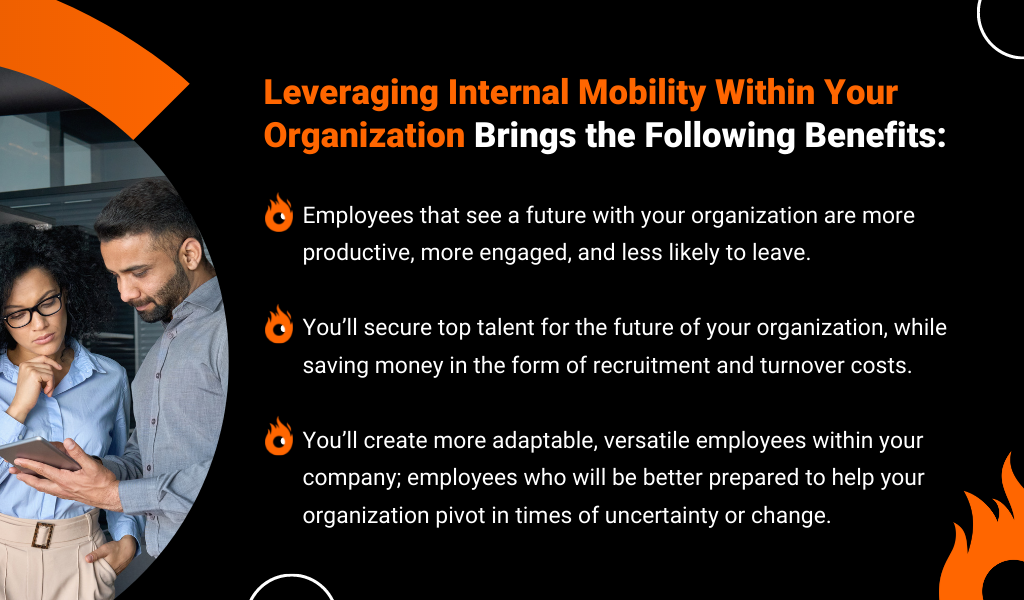Internal mobility isn’t a new concept; however, it is having a profound moment in the talent acquisition space. In response to the talent shortage, organizations are investing in the movement of their internal teams to ensure high-level positions are guarded for future success.
If it has been a while since you reviewed your internal mobility strategy, you may need a refresher on the modern version of this succession planning. If this isn’t a method you’ve thought much about in the past, now is the time to do so. Internal mobility can help ensure that your top talent is always ready and willing to step into roles as they open up. By investing in internal mobility, you’re also investing in the future success of your organization.
What is Internal Mobility?
Internal mobility refers to employees’ upward or lateral movement within a company. But it’s more than just offering promotions when someone leaves a vacancy in the organization. A true internal mobility strategy is vital for the success of your team and company. This can include lateral moves, promotions, or even demotions. The key is that the move is made with the intention of developing the employee’s skills and preparing them for future roles. Internal mobility can provide numerous benefits for both employees and employers alike. A successful strategy is achieved by implementing a plan, process, and opportunities for growth and development before you’re ready to call upon the skill set.
[bctt tweet=”Internal mobility secures the future of your organization- is your team ready? Find out with this quick guide from @MojoHire:” via=”no”]
Bonus Content: Talent Acquisition and Internal Mobility Combine: Is Your Team Prepared?
Why Practice Internal Mobility?
For employees, internal mobility can lead to increased job satisfaction and career development opportunities. It can also help them to build a network of contacts within the organization and gain exposure to new ideas and ways of working. For employers, internal mobility can help to develop a pipeline of qualified candidates for future vacancies, improve employee retention rates, and increase diversity within the workforce. Leveraging internal mobility within your organization brings the following benefits:
- Employees who see a future with your organization are more productive, engaged, and less likely to leave.
- You’ll secure top talent for your organization’s future while saving money through recruitment and turnover costs.
- You’ll create more adaptable, versatile employees within your company; employees who will be better prepared to help your organization pivot in times of uncertainty or change.
Your organization is set up for long-term success when your culture breeds flexible employees with versatile skill sets. Now here’s how you do it.
Need to improve Quality of Hire? 4 Ways to Improve Recruiter and Hiring Manager Collaboration
Types of Internal Mobility
There are numerous types of internal mobility, and each will benefit a team differently. Here are a few ways you can leverage to grow your organization and achieve future goals.
Promoting Your Employees
Promotion is what often comes to mind when thinking of internal mobility. It’s a great way for the company to fill an open position with someone whose likely already knowledgeable in the industry and within the company expectations. It also creates the opportunity for employee engagement and trust, as your staff views it as a dedication to recognizing their hard work and helping fulfill their career goals.
A promotion sounds cut and dry, but that isn’t always the case. In some instances, a promotion can include a change in title and salary but doesn’t always mean a significant change to their job function (i.e., taking on a leadership role or giving an extra function to perform). Alternatively, it could mean being moved to a completely different department or team where their expertise may correlate well.
Regardless of the details, promotion should be a method of leveling up your employees to fill more senior roles to ensure an understanding of your processes and organizational specifics in leadership roles.
[bctt tweet=”Three (yes, three) different ways to implement internal mobility in your organization today: ” username=”MojoHire”]
Lateral Mobility
Lateral moves are just that, just a move to a similar position on a different team or department, usually without a change in compensation or seniority. Although it may not seem like it, lateral moves can often greatly impact both the company and your employees.
Take, for example, an employee whose skill set is easily transferable to another department that lacks those same skills. Or lacking someone with the seniority in your company to understand the bigger picture.
This is also beneficial to employees you notice are less engaged, thinking of a career change, or are just feeling stagnant in their current position. A lateral move keeps them within the comfort of the company they know while feeling more engaged, in control of their career, and having a renewed purpose.
Mentorship or Job Shadowing
This type of exposure is vital to an effective internal mobility strategy. Job sharing, job shadowing, extended education, and coaching all lead to your talent being better prepared for incoming opportunities within the company, plus reap the benefits of keeping employees engaged and focused on a greater purpose.
Coaching or mentoring comes naturally when you partner mid-level employees with senior employees or offer entry-level employees the opportunity to shadow a similar role in another department. This type of collaboration offers the chance to learn from each other, bridge the gap between different teams or functions, and create interest within their career pathing within the organization.
Bring Internal Mobility Into Your Talent Acquisition Process
MojoHire’s AI-enabled talent platform can help you achieve all of the above without changing your existing HR tech stack. Our unique platform sits atop your entire HR system ecosystem to intelligently analyze billions of data points like an expert recruiter to surface the perfect candidate – external, internal, or contingent.
MojoHire’s internal mobility tools match internal fit on the recruiting and employee sides. The system will match employees instantly to open opportunities they are an excellent fit for or can get recommendations on career trajectories they may be interested in.
Because MojoHire uses a robust AI to analyze candidate information, it does much better than legacy systems in identifying the best talent matches. Because MojoHire “understands” resumes and can identify relationships between different data types, it will pick up on best matches even if they don’t have the “right” keywords or phrases in their applications. This intelligence ensures that no good candidate goes overlooked, especially not one under your own roof.
Ensure retention of your top talent, help improve their engagement, and fill your open roles faster. Contact us today to find out how MojoHire can make your HR Tech work better for you.







